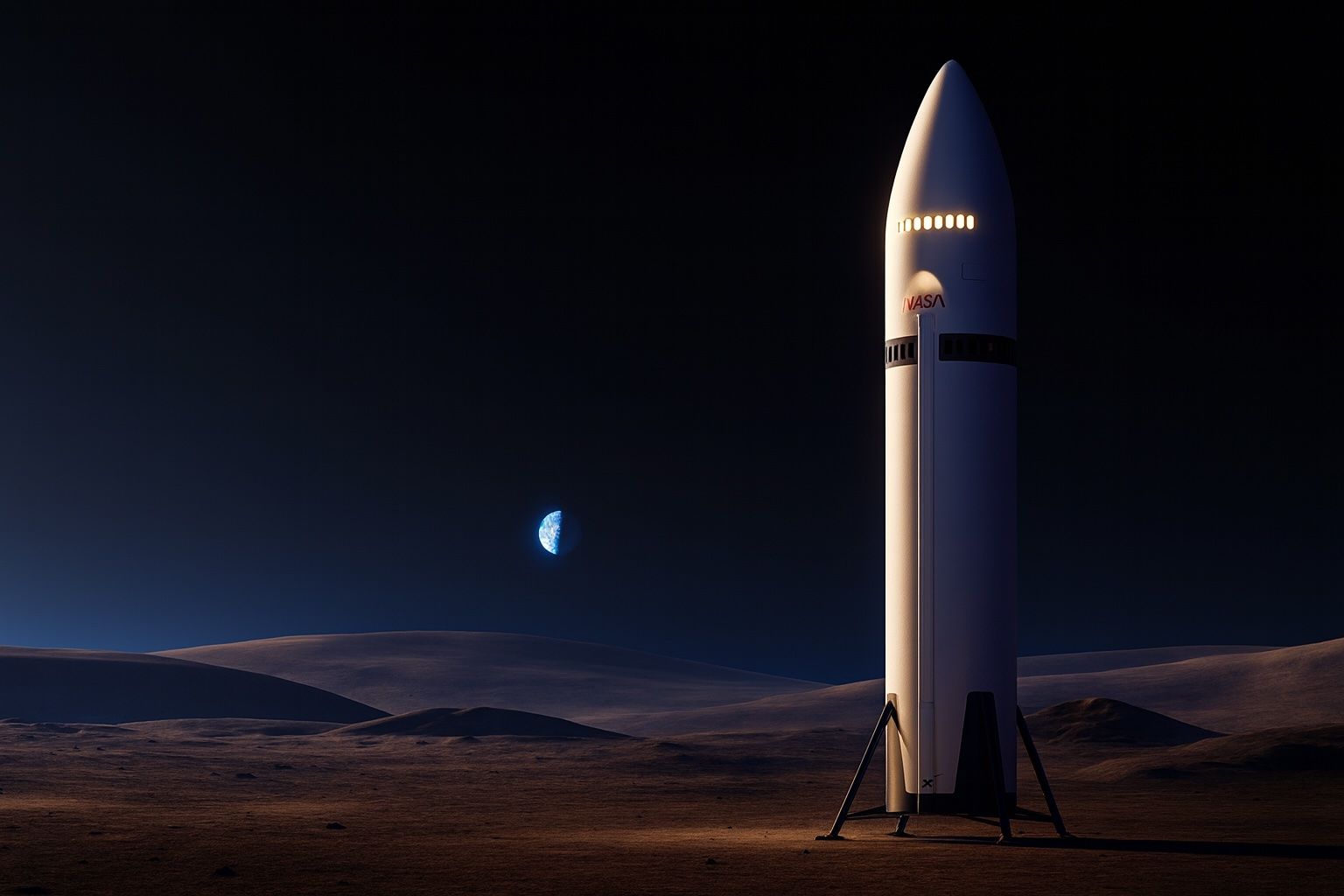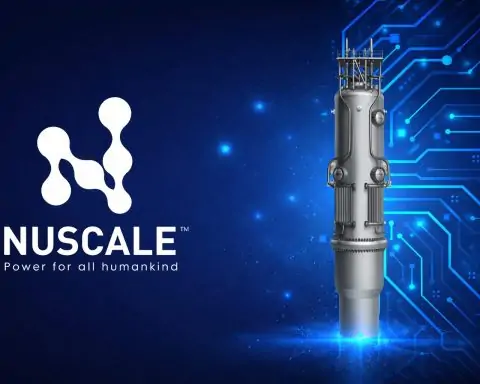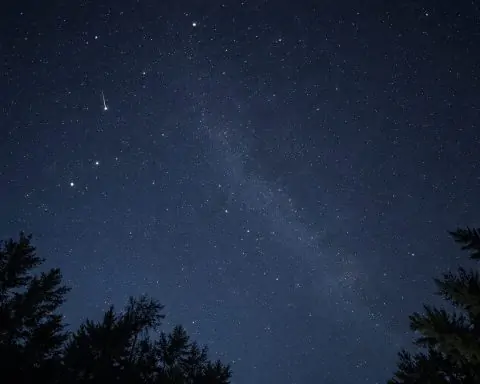- Artemis Moon Rocket Stacked: NASA has fully assembled its Artemis 2 mega-rocket with the Orion capsule on top, a key milestone as the agency races to return astronauts to the Moon [1]. The crewed Artemis 2 mission remains on track for early 2026, even as Artemis 3’s lunar landing slips to 2028 amid delays [2] [3].
- Moon Lander Shake-Up: Acting NASA Administrator Sean Duffy warned SpaceX is “behind” on its Starship moon lander and announced he’s reopening the Artemis 3 lander contract to competitors like Blue Origin [4]. “We’re in a race against China,” Duffy said, vowing not to “wait for one company” to get Americans back on the Moon [5] [6].
- Mars Rover’s Life Hint: NASA’s Perseverance rover uncovered a Martian mudstone rock laced with organic molecules and minerals (vivianite, greigite) that on Earth form from microbial activity [7] [8]. Scientists call it a “potential biosignature”, the clearest sign of life we’ve ever found on Mars, while stressing it’s not proof of life without further analysis [9] [10].
- Interstellar Comet Flyby: A rare interstellar comet designated 3I/ATLAS is swooping through our solar system, reaching perihelion on Oct. 29–30 with a dramatic sunward-pointing “anti-tail” [11] [12]. NASA’s telescopes have been tracking this alien comet, finding an exotic chemistry – CO₂ levels eight times higher than water – but no signs of any alien technology [13] [14].
- Global Science Partnerships: Despite a U.S. government shutdown that furloughed over 15,000 NASA staff, critical missions like the ISS and Artemis continued with skeleton crews [15] [16]. In a bright spot for international collaboration, the joint NASA–ISRO “NISAR” satellite delivered its first radar images of Earth, which NASA hailed as “a testament to what can be achieved when we unite around a shared vision” [17] [18].
Artemis on the Fast Track – and a New Moon Race
NASA’s Moon program reached a major milestone this week: engineers at Kennedy Space Center finished stacking the Space Launch System (SLS) rocket for Artemis 2, placing the Orion crew capsule (nicknamed “Integrity”) atop the booster [19]. “The towering rocket…has come together,” NASA announced, after hoisting Orion onto SLS inside the Vehicle Assembly Building [20]. This completed rocket – set to launch four astronauts around the Moon – was even exempted from the ongoing federal shutdown, underscoring Artemis 2’s high priority [21]. The mission is targeting February 2026 for liftoff, which would mark the first crewed journey beyond Earth orbit since Apollo 17 in 1972 [22] [23].
Acting Administrator Sean Duffy confirmed Artemis 2 remains on schedule, but he acknowledged growing concerns about Artemis 3, the first lunar landing mission. In a candid CNBC interview, Duffy criticized SpaceX’s slow progress on its Starship lander: “I love SpaceX… The problem is, they’re behind. They’ve pushed their timelines out, and we’re in a race against China” [24]. China has announced plans for its own crewed Moon landing by 2030, and the White House has pressed NASA to beat that date [25]. “The president and I want to get to the Moon in this president’s term,” Duffy emphasized [26]. (President Donald Trump, re-elected in 2024, has made NASA’s lunar return a top priority of his term ending January 2029 [27].)
To ensure an American Moon landing by 2028, NASA is making a dramatic course correction. Duffy declared he is opening Artemis 3’s lunar lander contract to competition after having relied solely on SpaceX [28] [29]. “I’m gonna open up the contract…I’m gonna let other space companies compete…like Blue Origin,” he said [30]. Under the original plan, SpaceX’s $4.4 billion Starship would ferry astronauts from lunar orbit to the surface [31]. But Starship has yet to reach orbit or carry crew, and only recently completed its 11th suborbital test flight on Oct. 13 (finally with full success) [32]. Facing that reality, NASA is inviting Blue Origin – which already has a $3.4 billion contract for an Artemis 5 lander – and others to vie for Artemis 3 [33]. “We won’t wait for one company” to get us back to the Moon, Duffy said, hinting that “two potential companies” might even team up for the 2028 landing if it accelerates the timeline [34].
This shake-up effectively ignites a new space race, not just against China but among U.S. companies. “We’re going to have a space race…American companies competing to see who can actually get us back to the Moon first,” Duffy told Fox News [35] [36]. The renewed urgency comes after Artemis 3’s schedule slipped from 2025 to 2027 and now likely 2028 [37] [38]. NASA officials concede that even 2027 was “already in jeopardy” due to Starship and spacesuit delays [39]. By reopening bids, NASA hopes to keep 2028 viable. Blue Origin, led by Jeff Bezos, is expected to propose an earlier version of its Blue Moon lander (originally planned for Artemis 5) in a bid to leapfrog SpaceX [40] [41]. Elon Musk has publicly scoffed at Blue Origin’s capabilities – noting it “has never delivered a payload to orbit” – but NASA clearly wants a backup plan [42].
Meanwhile, Artemis 2 preparations continue unabated. NASA’s teams have mated Orion’s stage adapter and completed all major stacking tasks [43]. The four Artemis 2 astronauts (three Americans and one Canadian) are deep into training. They will loop around the far side of the Moon and return in a 10-day mission, testing Orion’s life support and heat shield ahead of the Artemis 3 landing [44] [45]. Despite budget uncertainty, Duffy insists Artemis 2 “will launch… as early as February” 2026 [46]. This mission is exempt from the funding freeze and has continued work throughout October [47]. NASA and its partners – including Canada and Europe (who built Orion’s service module) – view Artemis 2 as the crucial stepping stone to boots on lunar soil.
Duffy also invoked the geopolitical stakes. Lawmakers warn that if the U.S. fails to return to the Moon first, it could cede “space leadership” to China [48]. The Artemis Accords, a U.S.-led framework for peaceful Moon exploration now signed by nearly 60 nations, underscore the broad international support behind NASA’s lunar ambitions [49]. But execution falls to NASA. “I’ll be damned if that’s the story we write,” Duffy has said about the prospect of losing the Moon race to Beijing [50]. His agency’s recent moves – keeping Artemis funded during the shutdown, holding contractors accountable, and fanning competition – all aim to “move the needle” toward a successful landing by 2028 [51] [52].
Mars Rover Uncovers a Tantalizing Life Clue
On Mars, NASA may have inched closer to answering the age-old question: did life ever exist there? The Perseverance rover has discovered what scientists are calling the most intriguing biosignature hint on the Red Planet so far. In the dry bed of an ancient river delta on Jezero Crater’s western rim, Perseverance examined a flat mudstone nicknamed “Cheyava Falls” [53]. This rock’s surface is mottled with peculiar dark speckles (“poppy seeds”) and ring-like discolorations (“leopard spots”) – signs that caught researchers’ attention back in 2024 [54] [55].
After a year of painstaking analysis, NASA announced the results: the rock’s odd spots are rich in organic carbon, accompanied by minerals like vivianite and greigite (iron phosphates and sulfides) tightly packed in the sediment [56] [57]. On Earth, such a combination typically arises from microbial activity. When microbes in oxygen-poor environments “breathe” minerals, they can leave behind those exact compounds as byproducts [58] [59]. That makes this Martian sample a compelling “potential biosignature” – a chemical feature that could be evidence of past life [60] [61].
Scientists are cautiously excited. “This is the moment where the metal detector has gone off and you’ve dug up something shiny,” said Dr. Joel Hurowitz of Stony Brook University, lead author of a new study on the find. “You still need to find out exactly what you’ve got – but you’ve got something to work with” [62]. In other words, Mars has finally served up a sample worthy of a treasure hunt. Even NASA’s chief was struck by the implications: Duffy called it “the clearest sign of life that we’ve ever found on Mars” [63]. Coming from NASA leadership, that is a remarkable statement.
Yet, officials are not declaring life found – not yet. Dr. Nicky Fox, head of NASA’s science directorate, cautioned that these results are “not life itself” or definitive proof of ancient microbes [64]. Similar mineral patterns can potentially form through rare non-biological chemistry. So the team emphasizes that alternative, abiotic explanations haven’t been ruled out [65] [66]. “We cannot claim this is more than a potential biosignature… we cannot rule out [non-biological] processes completely on the basis of rover data alone,” Dr. Hurowitz explained [67]. In short, Mars is teasing us with a strong hint, but confirming it will take more work.
That work could come in the form of Mars Sample Return (MSR) – an ambitious plan to bring Perseverance’s rock samples back to Earth labs. Perseverance has already sealed the intriguing mudstone core (dubbed “Sapphire Canyon”) in a titanium tube for future pickup [68]. An MSR campaign was in development with European partners, but its fate is now uncertain. NASA’s latest budget turmoil put the multi-billion-dollar project on the chopping block. The current U.S. budget proposal would cancel MSR entirely, due to escalating costs [69]. Duffy acknowledged the challenge, saying NASA is now “exploring alternative ways” to retrieve or study the samples if the original plan falls through [70]. “We’re looking at how we get the sample back…how do we spend money better, and what technology do we have to get samples back more quickly?” Duffy said, noting the funding squeeze [71].
One possibility is to analyze samples on Mars using advanced instruments on future rovers, or even send a pared-down return mission later. Another outside-the-box idea floated in the space community: could another country retrieve Perseverance’s samples if NASA cannot? China, for instance, is planning its own sample-return attempt from Mars in the 2030s, and some experts mused whether an international solution might emerge [72]. For now, NASA hasn’t given up on MSR, but the timeline will likely slip. In the meantime, Perseverance continues to rove Jezero Crater, drill new samples, and snap high-resolution photos of Mars’ sedimentary secrets. Each finding like Cheyava Falls refines our understanding of ancient Mars – a world that might have once harbored microbial life in its lakes and rivers.
The excitement is palpable in the scientific community. One astrobiologist described the discovery as finding a “shiny new clue” in the hunt for life [73]. Redox chemistry – the give-and-take of electrons in minerals like those Perseverance found – is fundamental to life’s energy cycles on Earth [74] [75]. Seeing traces of it locked in 3.6-billion-year-old Martian rocks raises the possibility that life’s fingerprints are preserved there [76] [77]. “Whatever their origin, this is a very distinct chemistry than anything we’ve seen in ~20–25 years of roving the planet,” said Dr. Hurowitz [78]. Even if non-biological, he added, it could be “prebiotically useful chemistry we haven’t thought about” – perhaps revealing how far natural processes went toward life’s threshold on Mars [79] [80].
In short, Mars just became a lot more interesting. Perseverance’s findings will spur “real arguments” and new experiments as scientists worldwide puzzle over the data [81]. A peer-reviewed study appears in Nature, lending weight to the results [82]. And NASA’s Martian quest is far from over: the Perseverance team is already scouting its next drill sites, while sister rover Curiosity continues exploring Gale Crater (now in its 12th year). As one NASA project scientist put it, “we now have the first hints… and that excites me!” [83]. The red planet may yet yield a definitive answer – but for that, those rock samples might ultimately need to take a very expensive trip to Earth.
A Visitor From Beyond: Interstellar Comet 3I/ATLAS
Not all the action is on Earth and Mars – a cosmic interloper from outside our solar system has been thrilling astronomers this month. The object known as 3I/ATLAS (or C/2025 N1) is only the third confirmed interstellar visitor ever observed, following ‘Oumuamua in 2017 and Comet 2I/Borisov in 2019 [84]. Unlike its predecessors, 3I/ATLAS is putting on a show akin to a classic comet – with some bizarre twists.
Discovered on July 1 by the ATLAS survey telescope in Chile, 3I/ATLAS was quickly recognized as interstellar due to its extreme speed (~58 km/s) and hyperbolic orbit not bound to the Sun [85]. Now, in late October, it’s making its closest approach to the Sun (perihelion on Oct. 29–30) at about 1.4 AU – inside Mars’ orbit, but well beyond Earth’s distance [86]. (For those wondering, it will never come closer than ~1.8 AU from Earth, so there’s zero threat to us [87].) As it nears the Sun, comet ATLAS has sprung to life, venting gas and dust just like comets from our own solar system. But it’s also displayed an extraordinary feature: a bright sunward-facing jet, sometimes called an “anti-tail,” shooting out toward the Sun [88].
This “wrong-way” tail is actually an optical illusion of perspective – we are seeing large dust particles left behind in the comet’s orbit, appearing to point sunward – but it’s nonetheless a striking sight [89]. 3I/ATLAS’s main tail, as expected, streams out in the opposite direction (away from the Sun, pushed by the solar wind) [90]. Together they give the comet a peculiar double-tailed appearance. Images from the Hubble Space Telescope back in July already showed ATLAS sporting a teardrop-shaped coma and a faint tail [91]. Now ground-based observers report the comet’s anti-tail has grown “surprisingly dramatic”, aligned with its trajectory toward the Sun [92]. Such features have been seen in some regular comets, but they’re relatively rare and indicate unusual outgassing patterns.
Unsurprisingly, the comet’s weird behavior sparked wild speculation in some corners of the internet – invoking everything from alien spacecraft notions to a link with the famous “Wow!” radio signal of 1977 [93]. Even Harvard astronomer Avi Loeb (known for his ‘Oumuamua alien ship hypothesis) mused that the sunward jet could be a deliberate braking maneuver by an engineered object [94]. Mainstream scientists strongly reject these ideas. Dr. Michael Küppers of ESA said 3I/ATLAS “looks like a comet and it behaves like a comet,” nothing more [95]. No anomalies, no artificial signals or structures have been detected – just a lot of natural cometary activity [96]. In fact, researchers attribute the odd jet to seasonal effects on the comet’s rotation and solar heating, causing one side of its nucleus to erupt with material in our direction [97]. In short, it’s a comet, folks – but a very fascinating one.
NASA and ESA observatories have mobilized to learn as much as possible from this interstellar time capsule. The Hubble Space Telescope and James Webb Space Telescope (JWST) both snapped images and spectra of 3I/ATLAS as it approached the inner solar system [98]. Early findings reveal an unusual makeup: spectroscopy by JWST in August found the comet is extremely rich in carbon dioxide but relatively poor in water ice [99]. The CO₂/H₂O ratio is roughly 8:1 – “among the highest ever seen in a comet” [100]. In addition, scientists detected gaseous nickel coming off the nucleus, but little to no iron – a chemical quirk never observed in natural comets before [101]. These clues hint that 3I/ATLAS formed in a very cold, carbon-rich environment around another star, where exotic processes (like nickel carbonyl outgassing) could occur [102]. It may be essentially an ancient fragment of an exoplanetary system’s outer reaches.
Astronomers suspect 3I/ATLAS could be over 7 billion years old, possibly originating from the Milky Way’s distant thick disk of stars [103]. If so, it predates our Sun and has been wandering the galaxy for eons – truly a primordial time capsule from another stellar neighborhood [104]. The opportunity to directly sample its light and dust is invaluable. Worldwide, telescopes large and small are participating in an unprecedented global observation campaign [105]. Even spacecraft have joined in: in early October, two ESA probes around Mars (Mars Express and the Trace Gas Orbiter) managed to photograph 3I/ATLAS as it passed about 30 million km from Mars – the first time an interstellar object has been imaged from another planet’s vicinity [106]. Coming up, ESA’s JUICE probe (en route to Jupiter) will train its instruments on ATLAS in November after perihelion [107]. And intriguingly, calculations show that ESA’s Hera spacecraft (currently cruising toward an asteroid rendezvous) and NASA’s Europa Clipper (cruising toward Jupiter) will fly through the fringes of ATLAS’s expansive tail in the next few weeks [108]. Those spacecraft might be able to collect data on the comet’s dust or plasma from their unique vantage points – a totally unplanned bonus experiment [109].
For the public, unfortunately 3I/ATLAS is not bright enough to see with the naked eye. It’s hovering around 19th magnitude – a target for big telescopes and long-exposure photography. But scientists are making the most of it. They are comparing ATLAS with Borisov (which was a more “normal” comet chemically) and ‘Oumuamua (which was weirdly rock-like and didn’t have a visible coma) to expand our understanding of other star systems’ debris [110] [111]. Already, one clear takeaway is that interstellar comets can be very different from those born around our Sun, especially in composition. As NASA’s planetary defense officer Dr. Lori Glaze put it, each interstellar visitor is “a unique messenger from afar, carrying secrets of its home” – and we’re fortunate to catch them in our nets when we can.
With 3I/ATLAS rounding the Sun this week, astronomers will watch for any surprises at perihelion: Will it fragment? Brighten? Fizzle out? So far, the comet has behaved mostly as expected (aside from its photogenic anti-tail). Both NASA and ESA reassure that its path is well understood and poses no danger to Earth [112]. The science payoff, however, is immense. As one NASA expert said, “Humanity has waited a long time to study a comet from another star” [113] – and now we have one revealing its story day by day. In a year that’s seen meteoric breakthroughs in space, this alien comet is literally the icing on the cake – a reminder of how much wonder still awaits us out there in the dark between the stars.
Tech Triumphs, Earth Science and International Collaboration
Beyond the headlines of Moon shots and Mars life clues, NASA has also scored some quieter but significant technological and scientific wins here closer to home. One highlight is the NASA-ISRO Synthetic Aperture Radar mission, or NISAR – a new Earth-observing satellite developed jointly by the United States and India. Launched in late July from India’s Satish Dhawan Space Centre, NISAR is the first satellite to carry dual radars (L-band by NASA and S-band by ISRO) for comprehensive global environmental monitoring [114] [115]. This month, NISAR beamed back its very first test images, and they are impressive. In one radar snapshot of Maine’s Mount Desert Island (captured Aug. 21), forests appear bright green, water as black, and human-built areas as vivid magenta – showcasing the mission’s ability to see through clouds and map land cover in fine detail [116] [117].
NASA’s Sean Duffy applauded NISAR’s debut images as “only the beginning” of the science to come [118]. “They’re a testament to what can be achieved when we unite around a shared vision of innovation and discovery,” Duffy said, highlighting the partnership with India [119]. With its 12-meter wide radar antenna – the largest NASA has ever launched – NISAR will scan Earth’s entire land and ice surfaces every 12 days, detecting subtle changes in ecosystems, ice sheets, volcanos, and the crust itself [120] [121]. This capability is poised to help with disaster response (e.g. spotting ground deformation before a landslide), agriculture (tracking crop health and soil moisture), and climate science (monitoring glaciers and permafrost) [122] [123]. Nicky Fox, NASA’s science chief, said these first images are “a preview of the hard-hitting science NISAR will produce”, enabling researchers to study Earth’s changing surface “in unprecedented detail while equipping decision-makers to respond to natural disasters and other challenges.” [124] The mission exemplifies how international cooperation – in this case between NASA and the Indian Space Research Organisation – can advance cutting-edge Earth science. It also symbolizes NASA’s broader push to maintain U.S. “space dominance” through what Duffy calls “Gold Standard Science” [125], even as the agency focuses on Moon and Mars exploration.
Speaking of international teamwork, NASA’s longest-running human spaceflight effort – the International Space Station (ISS) – quietly kept the science going 250 miles above Earth, despite the turmoil on the ground. When the U.S. government shut down on Oct. 1 due to a budget impasse, NASA had to furlough roughly 83% of its workforce [126] [127]. Public outreach, research labs, and Mission Control staffing were pared to minimum levels. However, the seven crew members aboard the ISS (from NASA, Russia’s Roscosmos, ESA, and JAXA) were designated as critical personnel. A small team of flight controllers remained on duty to support the station’s operations, as any lapse could endanger astronaut safety [128]. Throughout early October, the ISS crew carried on with experiments in microgravity – ranging from biomedical studies to technology demos – and even took time to photograph Earth from orbit. Japanese astronaut Satoshi Furukawa, for instance, captured stunning photos of the aurora and a Pacific typhoon from the Cupola observatory, sharing them on social media to remind everyone that the ISS’s unique vantage point never closes [129] [130].
NASA officials confirmed that ISS, crew safety, and Artemis prep were excepted from the shutdown, aligning with the administration’s priorities [131]. Still, the agency felt the strain: training for future missions was interrupted, and research output slowed with so many scientists locked out of their labs [132]. Morale has been tested as well – this was the first significant shutdown NASA had experienced in years, coming on the heels of budget cuts and a “realignment” at JPL that saw 550 layoffs [133]. By Oct. 27, there was optimism that a funding deal would soon allow NASA to resume full operations, but longer-term budget uncertainties remain. In the meantime, the international partnerships proved their resilience. Russian and American mission controllers kept the station flying safely, and a SpaceX Dragon cargo vehicle undocked on Oct. 6 as scheduled, returning research samples to Earth even in the midst of the agency’s partial closure (thanks to its automated systems and a slim ground crew).
Elsewhere in NASA’s portfolio, commercial space developments also made news. SpaceX’s Starship Flight 11 on Oct. 13 achieved the program’s first fully successful high-altitude test of the Starship/Super Heavy system [134]. The 400-ft rocket soared from Starbase, Texas and landed without exploding – a breakthrough that boosted confidence in SpaceX’s approach and sent space industry stocks climbing [135] [136]. (Starship will need several orbital test flights before it’s human-rated for Artemis, but this test was a big step forward.) Meanwhile Intuitive Machines, a small Houston company set to send a private lander to the Moon later this year, saw its stock ($LUNR) jump over 20% after securing new NASA contracts [137]. And Rocket Lab, a launch provider, has surged 170% in share price this year on a record cadence of missions, leading some analysts to dub it an “earlier-stage alternative to SpaceX” for investors [138]. The space economy as a whole seems energized by NASA’s momentum on Artemis and the prospect of a sustained lunar exploration program – a sharp turnaround from a decade ago when such ambitions were uncertain.
Finally, NASA’s leadership is navigating these opportunities and challenges with an eye on the future. Administrator Duffy, who interestingly is also serving as U.S. Transportation Secretary [139], has indicated NASA will refocus some priorities under the current administration. That likely means a stronger emphasis on human exploration (Moon/Mars) and national security space, with comparatively less on climate and Earth science if budgets force tough choices [140] [141]. (NASA’s Earth science and climate projects have been robust, as evidenced by missions like NISAR, but they could face headwinds if funding shifts.) At the International Astronautical Congress this month in Azerbaijan, NASA officials reaffirmed their commitment to the Artemis Accords and called on more nations to join the lunar endeavor [142]. With 59 countries now signed on, NASA is leveraging global support even as it contends with domestic budget politics [143].
In summary, it’s been a remarkable few days for NASA – and by extension, for humanity’s march into space. A Moon rocket stands ready, carrying the hopes of a new lunar generation. A rover on Mars has delivered perhaps our best clue yet that life once flickered on another world. A comet from another star is zipping by, whispering ancient secrets to our telescopes. And here on Earth, scientists and engineers from across the globe are working together – sometimes under adverse conditions – to push the frontiers of knowledge. “We have to move the needle,” as an Artemis astronaut recently said of their mission [144]. Indeed, NASA is moving the needle on multiple fronts, turning science fiction aspirations into concrete achievements. Each success, whether it’s a flawless rocket stacking or a spectral reading of interstellar ice, reminds us that space is the arena where nations, industries, and ideas are now racing forward. Stay tuned – this new space age shows no signs of slowing down as we close out 2025, and the discoveries just over the horizon might be truly game-changing.
Sources:
- NASA Artemis II stacking update – Space.com [145] [146]; CNBC interview quotes – Space.com [147] [148]; Artemis contract competition – TechStock² (ts2.tech) [149] [150]; SpaceX delays and Moon race – Space.com [151] [152].
- Perseverance rover “potential biosignature” discovery – Space.com [153] [154]; NASA/Science press briefing details – TechStock² [155] [156]; Expert commentary – Space.com [157]; Cautionary statements – TechStock² [158] [159]; Mars Sample Return budget issues – TechStock² [160].
- Interstellar comet 3I/ATLAS observations – TechStock² [161] [162]; NASA/ESA expert debunking alien rumors – TechStock² [163] [164]; JWST composition findings – TechStock² [165]; Global observation campaign – TechStock² [166] [167].
- NASA-ISRO NISAR first images and quotes – Tech Explorist [168] [169]; Nicky Fox quote – Tech Explorist [170]. ISS operations during shutdown – Space.com [171] [172]. Government shutdown impact on NASA – Space.com [173] [174]. Artemis Accords signatories – U.S. State Dept./White House [175] [176]. Space industry developments – TechStock² [177].
References
1. www.space.com, 2. www.space.com, 3. www.space.com, 4. www.space.com, 5. www.space.com, 6. ts2.tech, 7. www.space.com, 8. www.space.com, 9. ts2.tech, 10. ts2.tech, 11. ts2.tech, 12. ts2.tech, 13. ts2.tech, 14. ts2.tech, 15. www.space.com, 16. www.space.com, 17. www.techexplorist.com, 18. www.techexplorist.com, 19. www.space.com, 20. www.space.com, 21. www.space.com, 22. www.space.com, 23. www.space.com, 24. www.space.com, 25. ts2.tech, 26. www.space.com, 27. ts2.tech, 28. ts2.tech, 29. ts2.tech, 30. www.space.com, 31. ts2.tech, 32. www.space.com, 33. ts2.tech, 34. ts2.tech, 35. ts2.tech, 36. ts2.tech, 37. www.space.com, 38. www.space.com, 39. www.space.com, 40. www.space.com, 41. ts2.tech, 42. www.space.com, 43. ts2.tech, 44. www.space.com, 45. www.space.com, 46. www.space.com, 47. www.space.com, 48. www.space.com, 49. www.whitehouse.gov, 50. www.space.com, 51. www.space.com, 52. ts2.tech, 53. www.space.com, 54. www.space.com, 55. ts2.tech, 56. www.space.com, 57. www.space.com, 58. www.space.com, 59. www.space.com, 60. ts2.tech, 61. ts2.tech, 62. www.space.com, 63. ts2.tech, 64. ts2.tech, 65. ts2.tech, 66. ts2.tech, 67. ts2.tech, 68. ts2.tech, 69. ts2.tech, 70. ts2.tech, 71. ts2.tech, 72. www.space.com, 73. www.space.com, 74. www.space.com, 75. www.space.com, 76. www.space.com, 77. www.space.com, 78. www.space.com, 79. www.space.com, 80. www.space.com, 81. www.space.com, 82. ts2.tech, 83. www.space.com, 84. ts2.tech, 85. ts2.tech, 86. ts2.tech, 87. ts2.tech, 88. ts2.tech, 89. ts2.tech, 90. ts2.tech, 91. ts2.tech, 92. ts2.tech, 93. ts2.tech, 94. ts2.tech, 95. ts2.tech, 96. ts2.tech, 97. ts2.tech, 98. ts2.tech, 99. ts2.tech, 100. ts2.tech, 101. ts2.tech, 102. ts2.tech, 103. ts2.tech, 104. ts2.tech, 105. ts2.tech, 106. ts2.tech, 107. ts2.tech, 108. ts2.tech, 109. ts2.tech, 110. ts2.tech, 111. ts2.tech, 112. ts2.tech, 113. ts2.tech, 114. www.techexplorist.com, 115. www.techexplorist.com, 116. www.techexplorist.com, 117. www.techexplorist.com, 118. www.techexplorist.com, 119. www.techexplorist.com, 120. www.techexplorist.com, 121. www.techexplorist.com, 122. www.techexplorist.com, 123. www.techexplorist.com, 124. www.techexplorist.com, 125. www.techexplorist.com, 126. www.space.com, 127. www.space.com, 128. www.space.com, 129. www.space.com, 130. www.space.com, 131. www.space.com, 132. www.space.com, 133. www.space.com, 134. www.space.com, 135. ts2.tech, 136. ts2.tech, 137. ts2.tech, 138. ts2.tech, 139. ts2.tech, 140. www.space.com, 141. www.space.com, 142. www.openaccessgovernment.org, 143. www.whitehouse.gov, 144. www.space.com, 145. www.space.com, 146. www.space.com, 147. www.space.com, 148. www.space.com, 149. ts2.tech, 150. ts2.tech, 151. www.space.com, 152. www.space.com, 153. www.space.com, 154. www.space.com, 155. ts2.tech, 156. ts2.tech, 157. www.space.com, 158. ts2.tech, 159. ts2.tech, 160. ts2.tech, 161. ts2.tech, 162. ts2.tech, 163. ts2.tech, 164. ts2.tech, 165. ts2.tech, 166. ts2.tech, 167. ts2.tech, 168. www.techexplorist.com, 169. www.techexplorist.com, 170. www.techexplorist.com, 171. www.space.com, 172. www.space.com, 173. www.space.com, 174. www.space.com, 175. www.whitehouse.gov, 176. www.openaccessgovernment.org, 177. ts2.tech










